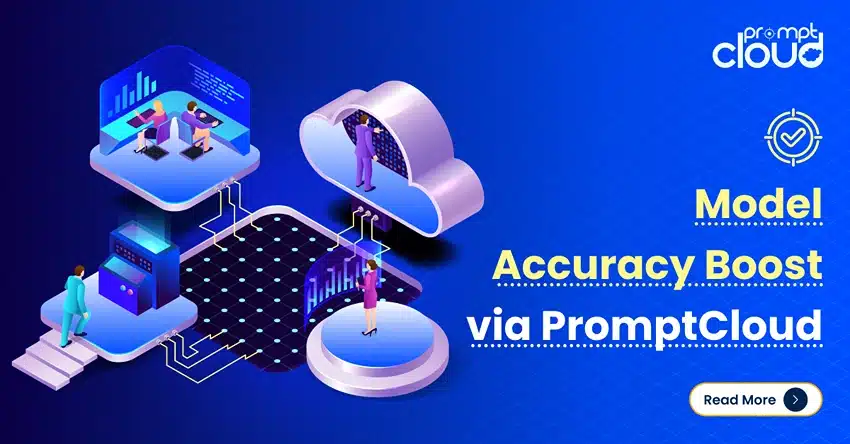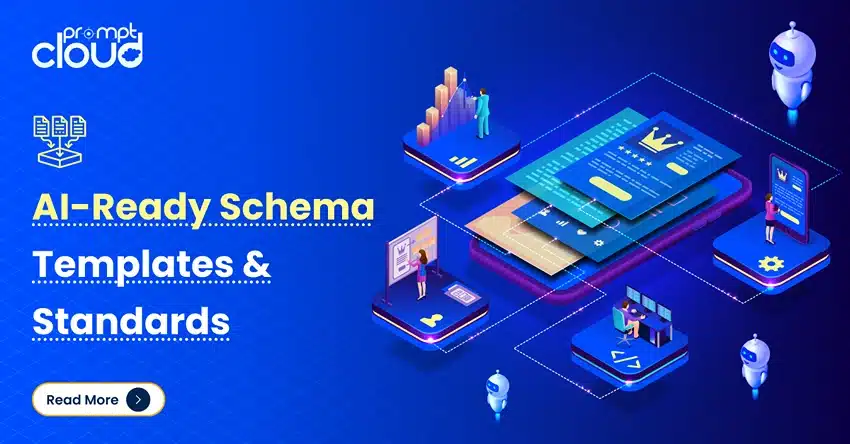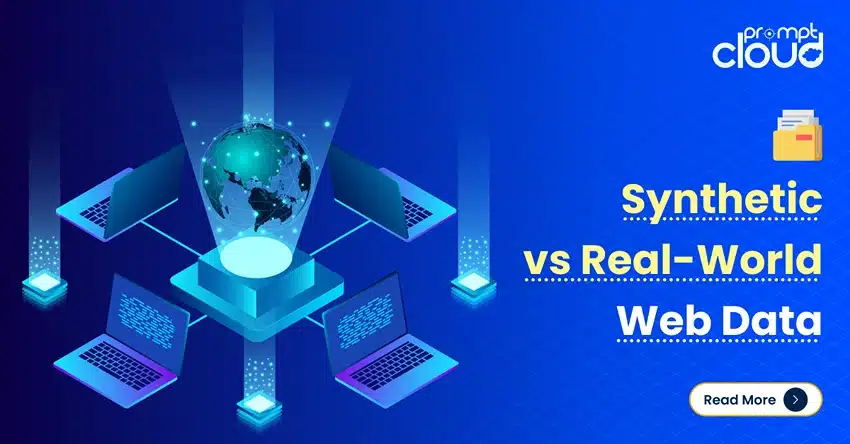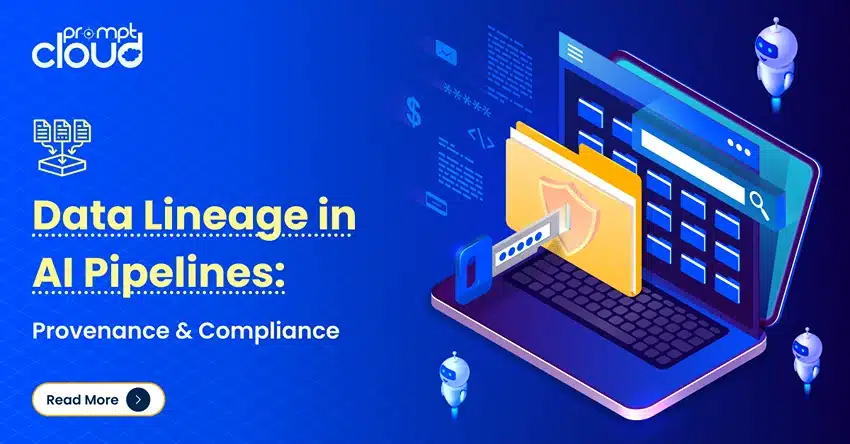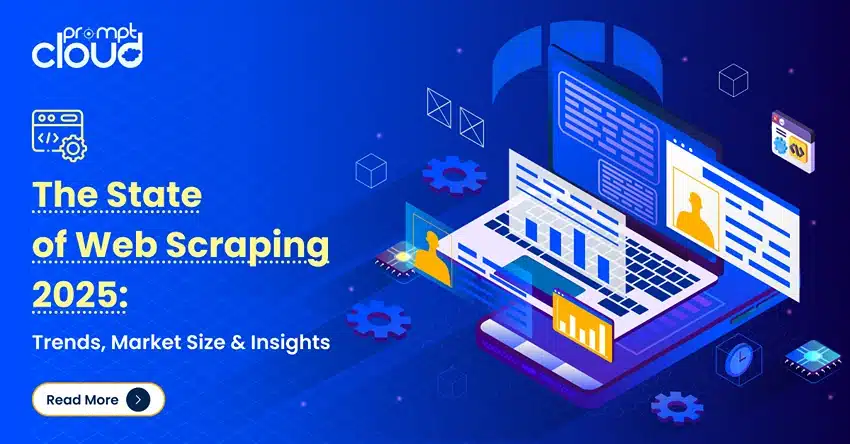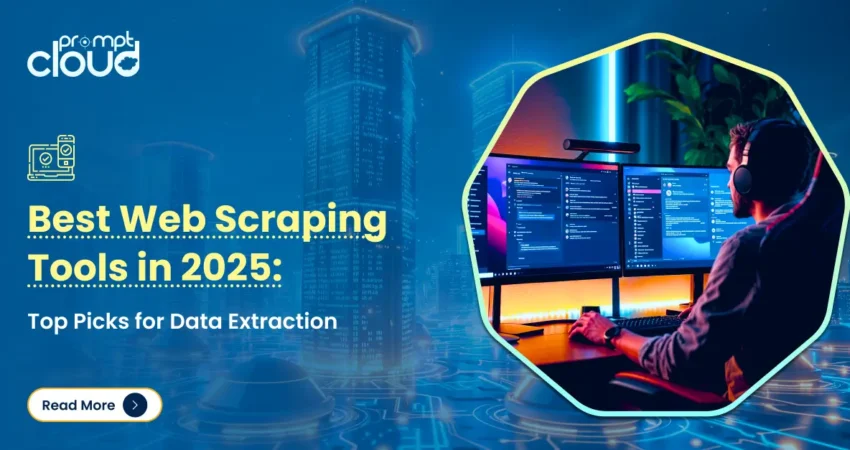
In 2025, the volume of data being created and shared online is staggering—Statista estimates it’ll top 180 zettabytes globally. A big chunk of that lives on public websites in the form of product listings, prices, reviews, job ads, real estate data, and more. For businesses and analysts trying to tap into this information, web scraping has become an essential tool.
The real question now isn’t if you should be using web scraping—it’s which tool will help you do it best. With so many platforms out there, finding the right fit for your project can be overwhelming.
In this guide, we’ll break down the best web scraping tools for 2025—covering both free and paid options—so you can choose the right one based on your data goals, technical skills, and budget.
How Businesses Use Web Scraping Tools for Data Extraction
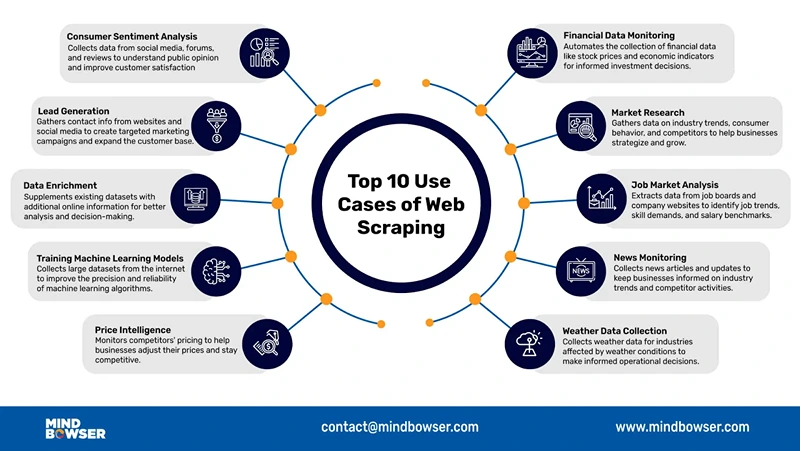
Image Source: Mindbrowser
Web scraping has evolved into much more than just a developer’s hobby and has become essential to the functioning of many businesses across industries. We’ve compiled a list of the best tools for web scraping and how companies have implemented them:
- E-commerce websites utilize web scraping tools to track competitor prices and stock levels, and optimize product descriptions across different marketplaces.
- Recruitment firms scrape job boards and company career pages to build comprehensive job databases for better talent insights.
- Market research agencies rely on scraping tools to gather customer reviews, product feedback, and trends across forums, news portals, and social platforms.
- Real estate aggregators extract data from property listing sites to provide users with real-time availability, price trends, and neighborhood insights.
- Financial institutions use web scraping to gather news headlines, SEC filings, and public data to feed their trading algorithms and risk models.
All these cases emphasize the critical importance of precision, quickness, and scalability. This is the primary reason why companies spend considerable effort searching for the best web scraping tools to meet their unique needs.
What to Look for When Choosing a Web Scraping Tool in 2025
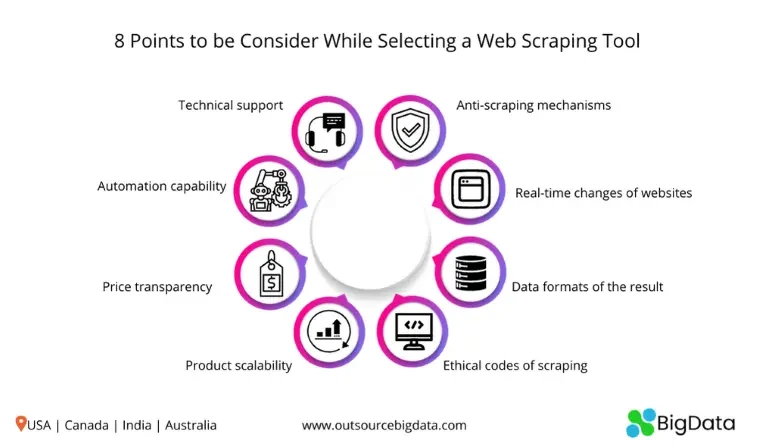
Image source: Outsourcebigdata
Not every scraping tool is built the same. What works for a small script-based project may not hold up under an enterprise-level scale. Before you decide which tool to use, here are the key things to consider:
1. Ease of Use: Some tools are designed for developers with strong coding skills, while others offer no-code interfaces for business users. Choose what matches your technical comfort.
2. Scalability: Can the tool handle scraping millions of pages without performance drops? If your data needs are high-volume, this becomes crucial.
3. Anti-bot Handling: Modern websites use CAPTCHAs, rate-limiting, and bot detection. A good scraping tool should be able to bypass these using smart techniques like rotating IPs or headless browsers.
4. Automation and Scheduling: Look for tools that allow you to schedule scraping jobs, automate exports, and integrate easily with your existing workflows.
5. Data Format Support: Whether you need data in CSV, JSON, Excel, or fed directly into a database, check if the tool supports your preferred output format.
6. Pricing: There’s a wide range—from free and open-source tools to enterprise-grade solutions with premium features. Understanding your budget helps narrow down your options.
By balancing these factors, you’ll be better prepared to identify the best web scraping tools suited for your organization’s needs.
What Are the Best Web Scraping Tools in 2025? A Look at the Top Categories
Before getting into specific options, it is important to know that not all scraping tools are created equally. Depending on your skill set, business objectives, or the level of intricacy involved in webpages, the perfect tool for one person might not suit another.
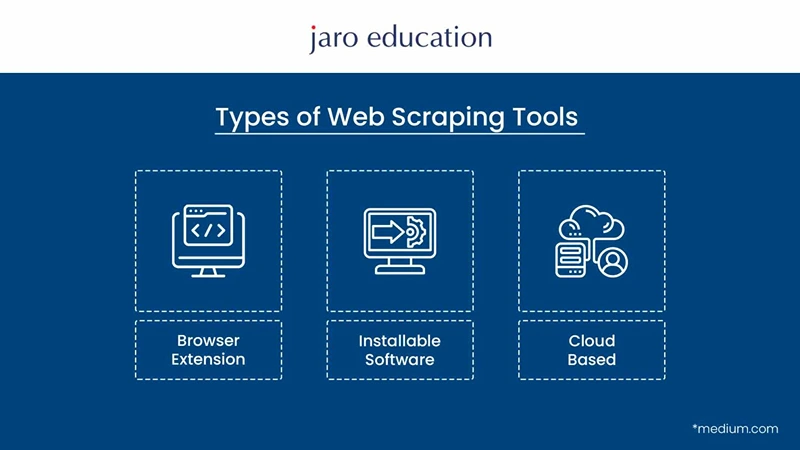
Image Source: Jaro Education
Here are the major categories of tools you’ll come across when searching for the best web scraping tools today:
1. Browser-Based Scraping Tools
These are usually browser extensions or standalone desktop apps that allow users to visually select data elements on a webpage and extract them with little or no coding. Tools in this category are user-friendly and ideal for small-scale projects or one-time extractions.
2. API-Driven Scraping Tools
Some services offer ready-made APIs that return structured data from popular websites (e.g., Amazon, LinkedIn, and X (formerly Twitter)). These are great when you need data from specific sources and don’t want to deal with the scraping process directly. They’re also more stable and easier to maintain.
3. Cloud-Based Scraping Platforms
Cloud scraping platforms are hosted online and typically come with automation, scheduling, proxy rotation, and robust anti-blocking mechanisms. These tools are scalable, reliable, and suitable for businesses with ongoing and large-scale data needs.
4. Open-Source Libraries
For developers, open-source libraries like BeautifulSoup or Scrapy offer complete control. These tools allow you to write your own scraping scripts and customize them as needed. While flexible, they require a strong grasp of coding and infrastructure management.
5. Enterprise-Grade Scraping Solutions
These are comprehensive platforms often tailored to the specific needs of enterprises. They handle everything—from crawling and data extraction to cleaning and delivery. These solutions usually include customer support, compliance handling, and integration with data pipelines.
Each type of tool has its place depending on the user’s goals. Now that we’ve covered the types, let’s explore the best free web scraping tools available right now.
Best Free Web Scraping Tools in 2025
Beginners or those working on smaller tasks will appreciate the ease of use associated with free web scraping tools. While lacking in some advanced features, they are more than enough for testing purposes.
Here are some of the best free web scraping tools in 2025 that continue to gain popularity among developers, researchers, and data enthusiasts:
1. ParseHub
ParseHub is a visual web scraping tool that works through a browser extension and desktop app. It allows users to click on the data they want to extract and automatically creates the logic behind it.
- Key Features: Easy point-and-click interface, JSON/CSV export, support for dynamic sites.
- Pros: It is Beginner-friendly and supports JavaScript-heavy pages.
- Cons: Limited number of pages per project in the free tier.
2. Web Scraper.io
This Chrome extension lets users build sitemaps to define how data should be extracted from websites. It’s ideal for people who want to scrape websites regularly and understand the page structure.
- Key Features: Sitemap builder, automatic navigation, local and cloud scraping.
- Pros: No coding needed, good documentation.
- Cons: Struggles with complex websites or pages that rely on AJAX.
3. Octoparse (Free Plan)
Octoparse is one of the most user-friendly scraping tools out there. It offers a free version that includes many features typically reserved for paid plans in other tools.
- Key Features: Drag-and-drop workflow, auto-detection, scheduling options.
- Pros: Easy to use, handles pagination well.
- Cons: The Free plan has limits on cloud runs and export volume.
4. Apify (Free Tier)
Apify is a cloud platform where you can build and run scraping tasks using JavaScript or use pre-built “Actors” (apps). It also supports integrations and headless browser automation.
- Key Features: Customizable tasks, automation scripts, API integration.
- Pros: It is very flexible and supports large-scale scraping.
- Cons: Requires some technical knowledge; limited computing units on free plan.
5. Instant Data Scraper
This Chrome plugin detects patterns in webpage data automatically and allows you to download it without configuring selectors manually.
- Key Features: No setup needed, instant exports.
- Pros: Extremely easy for quick jobs.
- Cons: Limited control; not suited for complex or large-scale scraping.
These best free web scraping tools are a great starting point. However, as your data needs grow, you may find yourself running into roadblocks with performance, reliability, or anti-bot detection. That’s when paid tools come into the picture.
Best Paid Web Scraping Tools & Services for Enterprises in 2025
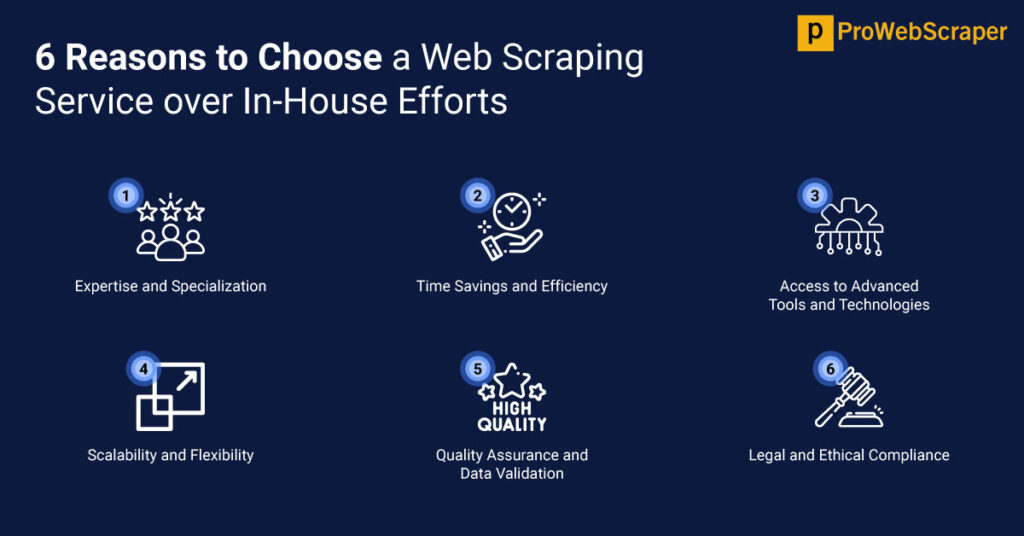
Image Source: Prowebscraper
While free tools are great for small projects, businesses often need something more robust—something that offers scalability, automation, support, and built-in defenses against anti-scraping measures. That’s where paid web scraping tools shine.
Let’s explore some of the best web scraping tools in the paid category that enterprises are using in 2025 to gain an edge through data.
1. PromptCloud
PromptCloud is a fully managed, enterprise-grade web scraping service that handles everything—from setting up crawlers to delivering clean, structured data.
- Key Features: Custom crawler development, real-time data delivery, support for large-scale projects, dedicated support team.
- Why Businesses Use It: PromptCloud removes the technical complexity by offering end-to-end data-as-a-service. It’s ideal for companies that don’t want to build and maintain their own scraping infrastructure.
- Downsides: Not self-serve; it’s a fully managed solution, which means it’s best suited for companies looking for long-term, ongoing data partnerships.
Get started today – Schedule a FREE demo!
2. Zyte
Zyte provides cloud-based scraping infrastructure, tools like Scrapy Cloud, and APIs for structured data delivery. Their smart proxy manager and automatic extraction tools are popular among developers.
- Key Features: Auto-extraction APIs, Smart Proxy Manager, Scrapy Cloud.
- Why Businesses Use It: Zyte is developer-friendly, supports large-scale scraping projects, and handles compliance and maintenance effectively.
- Downsides: Requires some coding skills and pricing scales quickly with volume.
3. Diffbot
Diffbot uses AI and machine learning to turn web pages into structured data. It crawls the web and returns data via APIs in formats ready for analysis.
- Key Features: Automatic content extraction, custom crawlers, AI-based structured data.
- Why Businesses Use It: Unlike traditional scrapers, Diffbot uses natural language processing to extract high-quality data. It’s especially popular for market research and business intelligence use cases.
- Downsides: It is Expensive and best suited for very specific needs like knowledge graph creation or data enrichment.
4. ScrapingBee
ScrapingBee is a newer but fast-growing player that focuses on rendering JavaScript-heavy websites and managing browser automation.
- Key Features: Headless browser rendering, simple API, CAPTCHA bypassing.
- Why Businesses Use It: Lightweight and easy to integrate, ScrapingBee is great for scraping sites like LinkedIn, Amazon, and Google Search.
- Downsides: Limited advanced features compared to older platforms.
5. Bright Data
Bright Data is one of the most well-known enterprise-level scraping platforms. It offers powerful data collection tools combined with a vast proxy network.
- Key Features: Residential proxies, scraping browser, data collector platform, 24/7 support.
- Why Businesses Use It: Bright Data’s strength lies in its ability to bypass bot detection using real-user IPs and a robust infrastructure. It also supports custom scraping scripts and integrates with analytics tools.
- Downsides: Pricing can be complex and steep, especially for small businesses.
These tools aren’t just scraping utilities—they’re full ecosystems that handle proxies, anti-bot challenges, scheduling, data structuring, and compliance. For businesses dealing with large volumes or sensitive targets, these best tools for web scraping are often worth the investment.
Free vs. Paid Web Scraping Tools: Which One Is Right for You?
Deciding whether to get a free tool or one that you have to pay for depends on your skill level, the level of technicality that is needed, and how important data is to your business. As such, this is a step-by-step guide outlining what web scraping tools are best suited for your unique circumstances:
| Factor | Free Web Scraping Tools | Paid Web Scraping Tools |
|---|---|---|
| Cost | Free to use and perfect for beginners or hobby projects. No upfront investment is needed. | Requires subscription or service fees. It has a higher cost but is designed for ROI through efficiency and scale. |
| Ease of Use | Tools like ParseHub and Web Scraper.io are beginner-friendly, with visual interfaces. | Paid platforms may offer more features, but some require onboarding or technical understanding. Many offer managed services. |
| Performance and Speed | Suitable for small-scale tasks. It can be slow or unreliable for larger websites or frequent scraping. | Built for scale—can handle millions of pages per day with robust infrastructure. |
| Handling Complex Sites | Often struggle with JavaScript-heavy websites, login-based pages, or CAPTCHA. | Use headless browsers, dynamic rendering, and advanced anti-bot techniques to bypass complex protections. |
| Automation and Scheduling | Limited automation. Some tools allow scheduling, but usually with restrictions. | Full automation available—schedule scrapers, set delivery intervals, and integrate with internal systems. |
| Customer Support | Usually no dedicated support. Users rely on forums or documentation. | Paid tools offer professional customer service, account managers, and dedicated technical teams. |
| Data Delivery Options | Mostly manual downloads (CSV/JSON). You’ll likely have to clean or transform the data yourself. | Flexible delivery via API, FTP, cloud buckets, or directly into dashboards in clean, structured formats. |
| Customization and Flexibility | Customization is limited unless you’re using open-source code and writing your scripts. | Highly customizable scraping flows, especially with tools like PromptCloud, are tailored to your business needs. |
| Scalability | Ideal for one-off tasks or small datasets. Not suitable for real-time or large-scale extraction. | Designed for high-volume, recurring, and enterprise-grade data needs. |
| Compliance and Legal Handling | You’re responsible for everything—data accuracy, terms of service, and privacy rules. | Enterprise tools often come with built-in compliance checks, data handling best practices, and legal frameworks. |
How to Choose the Best Web Scraping Tool for Your Needs
Reading through the features does not explain everything when it comes to selecting the right or best web scraping tools. It is mostly about syncing the tool with your objectives, particular requirements, and future goals. So whether it is for scraping prices, monitoring competitors, or updating AI models with fresh data, this is how you can make the right decision.
Understand Your Data Volume and Frequency
Are you scraping hundreds of product pages once a month? Or millions of listings daily across global e-commerce sites? Free tools are fine for small datasets, but they’ll buckle under pressure when your data volume scales. If you need regular, large-scale extraction, it’s best to look for paid tools that offer cloud-based automation and bandwidth.
Evaluate the Complexity of Target Websites
Sites that use JavaScript, AJAX, CAPTCHA, or require login credentials can be tough to scrape. If you’re targeting these, choose tools with dynamic rendering capabilities (like ScrapingBee or PromptCloud). Simple sites? A basic Chrome extension might do.
Factor in Automation and Scheduling Needs
If you’re pulling data regularly, manual extraction isn’t practical. Tools like Octoparse and Apify allow scheduled runs, but managed services like PromptCloud take it further by automating the entire pipeline—crawling, structuring, cleaning, and delivery—on your schedule.
Consider Your Technical Capabilities
Some of the best tools for web scraping require solid programming knowledge. Tools like Scrapy, Apify SDK, and BeautifulSoup are powerful but not beginner-friendly. If you or your team aren’t coders, go for platforms with visual interfaces or managed services that don’t require you to touch a line of code.
Think About Output Format and Integration
Getting the data is only half the battle. You also need to clean, store, and analyze it. Ask yourself: Does the tool export data in your preferred format (CSV, JSON, XML)? Can it plug into your CRM, database, or analytics tool? Managed services often tailor this part for you.
Budget vs. Value
Finally, consider not just the cost but the value. Free tools save money upfront but can cost you time and accuracy. Paid tools might feel expensive, but they free up your team, improve data reliability, and help you act faster on insights.
In the end, the best free web scraping tools are fantastic for trying things out, but as soon as your use case becomes serious, the ROI of a professional setup becomes clear.
The Right Tool Makes All the Difference
Web scraping in 2025 isn’t just a technical hobby—it’s a strategic business advantage. Whether you’re a solo developer pulling job listings or a data team powering a pricing engine, the tool you choose will shape your success.
Let’s recap:
- Free tools like ParseHub and Octoparse are great for small projects or learning the ropes.
- Paid tools like Bright Data, Zyte, and Diffbot offer scalability, automation, and battle-tested infrastructure.
- Managed solutions like PromptCloud remove the burden of setup and maintenance, letting you focus entirely on insights, not infrastructure.
The landscape of the best web scraping tools has grown more sophisticated, but that also means more choice—and more confusion. By aligning your needs with the right solution, you’ll save time, improve accuracy, and unlock powerful business intelligence.
Why PromptCloud is a Trusted Name in Web Scraping
At PromptCloud, we’ve spent over a decade helping businesses extract meaningful, structured data from the web—at scale. Whether you’re looking to track retail prices, analyze customer sentiment, or monitor global job markets, our enterprise-grade scraping solutions are designed to grow with your needs.
- Custom crawler development tailored to your target sites
- Real-time data delivery in your preferred format
- Full compliance and security are built into every solution
- Scalable architecture that handles millions of pages daily
With PromptCloud, you get more than a tool—you get a data partner. Our fully managed services mean no setup headaches, no blocked IPs, and no worries about legal compliance. Just clean, usable data delivered where and when you need it.Looking to go beyond the basics? Contact us today and explore how we can help you unlock web data with ease.









